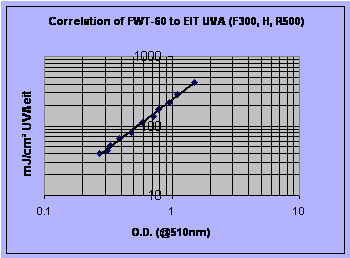Guide to UV Measurement
Radiochromic Films
Radiochromic dosimeters are tabs that attach to a test surface and respond to total time-integrated energy by changing color or by changing optical density. Depending on the chemistry of the detector, it can change permanently or only temporarily. These photochromic detectors typically respond to a wide range of UV wavelengths. Tabs or tapes that are interpreted by eye or by comparison to a printed color chart are considered less accurate and less repeatable than films read by instruments (colorimeters or densitometers).
They can be very handy, especially for 3-D objects, as a number of them can be placed about the object to measure and compare the energy delivered to any part of the surface. For flat curing, tabs and strips have the obvious advantage that they can be attached to a flat web or sheet and can survive transit through nips, rollers, and the like, without damage. They are inexpensive and easy to apply.
A drawback to radiochromic films is that they generally respond to and record accumulated energy only . In a multiple lamp system, they cannot distinguish the individual exposures of successive lamps. Commercial radiochromic films are not wavelength-specific. In fact, very little spectral responsivity data is available. Radiochromic chemistries tend to respond to short UV wavelengths, typically from 200 up to 300 or 350 nm. Some preparation has to be done in order to correlate the results of these films with either radiometer measurements, or physical properties, or both. Figure 1 illustrates the correlation of tabs whose optical density (at 510 nm) has been correlated specifically to an EIT PowerPuck ® radiometer. This type of correlation must be done for each specific exposure (type of bulb and spectral distribution). Once done, the correlation can make quick work of multiple measurements.

This suggests that these can be very effective for use in process monitoring or in evaluation of configurations in process design. Lacking a multiple sensor measurement system, radiochromic films can be helpful in the design of a system in the specific task of physical arrangement of lamps in, for example, surface curing of 3D objects. With more development in the area of responsivity and spectral calibration, radiochromic coatings and films could become a useful process control tool.